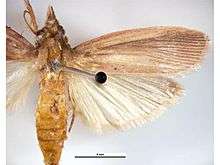Maliarpha separatella
| African white stemborer | |
|---|---|
 | |
| Scientific classification | |
| Kingdom: | Animalia |
| Phylum: | Arthropoda |
| Class: | Insecta |
| Order: | Lepidoptera |
| Family: | Pyralidae |
| Genus: | Maliarpha |
| Species: | M. separatella |
| Binomial name | |
| Maliarpha separatella Ragonot, 1888 | |
| Synonyms | |
| |
Maliarpha separatella, the African white stemborer, is a species of moth of the family Pyralidae. A worldwide paddy pest, it is found throughout African countries of Cameroon, La Réunion, Madagascar, South Africa,[1] and many Asian paddy cultivating countries such as Myanmar, India, and Sri Lanka as well. Though they are reported from China and Papua New Guinea, they are known to attack sugarcane instead of paddy.[2]
Description
The wingspan is about 20-30 mm. Palpi of male with second joint hollowed out to receive the brush-like maxillary palpi. Antennae with a sinus at base of shaft containing a ridge of scales. Palpi porrect. Male has rufous head and thorax. Abdomen ochroeus. Fore wings suffused with rufous, darkest below the broad pale costal fascia, which does not reach apex. Hind wings yellowish white. Female moth is much reddish in color, with a costal fascia often deeply suffused with red color.[3]
Ecology
The larvae feed on various grasses, including Zea mays, Andropogon tectorum, Oryza species, Saccharum sp., and Sorghum species.
Attack and control
Caterpillars are the major attacking stage, who are bore and tunneling in to the tillers, stem and feed on internal tissues and sap. The heavy attack show small, circular cavities in the stem, where this species rarely show symptoms of deadhearts or whiteheads.[4]
Controlling can be easy with practicing many cultural control and sanitary measures such as stubble rotting, adjusting planting date and adjusting planting density. Usage of trap crops is practiced in southwest Nigeria, which is known to be affecting against borers.[4]
Unlike other paddy pests, the biological control of this species is not very effective. This is due to the fact that, borers spend the larval stage within plant stems, rendering this method ineffective. But recent study stated five parasitoids that are effective to the borers, they are, Chelonus maudae, Rhacanotus carinafus, Prisfomerus bullis, Prisfomerus caris, and Venturia jordanae.[5]
Therefore, chemical control is an effective method of control.
References
- ↑ "Afro Moths". Afro Moths. Retrieved 2011-10-10.
- ↑ "Maliarpha separatella (African white rice borer)". CABI. Retrieved 31 October 2016.
- ↑ Hampson G. F. (1892). "The Fauna Of British India Including Ceylon And Burma Moths Vol-iv". Digital Library of India. p. 558. Retrieved 4 July 2016.
- 1 2 "African white rice borer biology". Plantwise Technical Factsheet. Retrieved 31 October 2016.
- ↑ "The parasitoids of the African white rice borer, Maliarpha separatella Ragonot (Lepidoptera: Pyralidae)". Bulletin of Entomological Research, Volume 84, Issue 1. Retrieved 31 October 2016.
External links
- Sampling egg batches of Maliarpha separatella RAG. (Lep., Pyralidae) in Madagascan rice fields
- Semiochemicals of Maliarpha separatella
- Sex pheromone of female african white rice stem borer,Maliarpha separatella (Lepidoptera: Pyralidae) from Sierra Leone: Identification and field testing